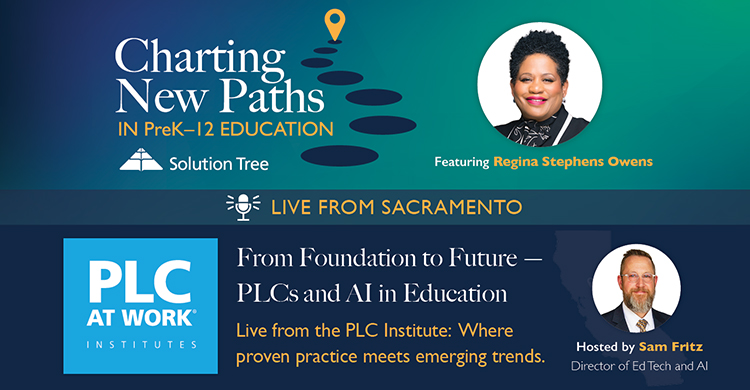Every year hundreds of educators visit White River School District to observe the work of our collaborative teams and the districtwide systems that are in place to impact the work of our teams. We invite them to pull up a chair alongside our teacher teams and observe how they analyze data along with student work, and plan for additional time, support, and extensions–kid-by-kid and skill-by-skill. We share the tools our teachers use, from the websites that house unit plans, resources, and data, to job descriptions for our team leaders, to data collection tools. By observing the teams in action the things we are “tight” about across the district quickly become apparent, as well as how the work throughout our district aligns—from the boardroom to the classroom.
Well, we finally got our act together and put it all into a book (Leading PLCs at Work Districtwide, 2021). This book provides practical, step-by-step guidance that we hope will ignite educators as they lead and align the work of a professional learning community districtwide. Chock-full of practical resources, it should become a coveted resource for any district.
Often PLCs focus on the work of teacher teams without recognizing the necessity of districtwide systems and tools to support the work of teams. Absent these systems, tools, and alignment the work of teacher teams becomes much more problematic.
“Effective top-down leadership can have a tremendous effect on the quality of the bottom-up work of school teams. It is unrealistic to think that teams throughout a district will be able to function at a high level if the school board and superintendent team is not functioning at a high level to develop a strong PLC foundation – the district mission, vision, values (shared commitments) and goals; embed a collaborative culture throughout the district; and create a commitment to a data-driven, research-based culture at every level within the district.” (Eaker, et al. 2021, p.13)
Teamwork is Key
So begins the first chapter. The graphic titled Aligning the Work of Collaborative Teams serves as a visual overview of the work. A high-performing school district that functions as a PLC reflects a thoughtful and deliberate integration of the work that flows from the school board to the central office, individual schools, and ultimately, the teacher teams. The original architects of the Professional Learning Community at Work process were crystal clear when they defined a PLC as “the larger organization and not the individual teams that comprise it” (DuFour et al. 2016, p.10). Individual teacher collaborative teams are indispensable for the PLC process to be successful. However, it is critical that teams in each grade level and every school in a district are part of a coordinated system that ensures high levels of learning for all students. A districtwide Professional Learning Community is more than the sum of its parts. Chapter-by-chapter the book lays out the work that must be done at each level, explaining in detail the systems and structures necessary for a district to reflect a high functioning PLC from the boardroom to the classroom, with the expectation of high levels of learning for all adults and students in the district.
Changing a school or district culture is a complex and difficult journey that requires first “getting started” then “getting better.” Getting started is the first big step, but not the last. And “getting better” requires continuous collective inquiry into best practices, enhanced specificity in our work, and a laser-like focus on what’s important, product-by-product, task-by-task.
In traditional districts, departments and schools often operate in silos. They are not aware of where they fit in the larger system, or how their work impacts the mission of the district. Their attention is focused on the immediate needs within their sphere. The result is often an uneven distribution of resources, which too often creates uneven levels of student achievement. When everyone is clear about how their role supports the district mission, and decisions are data-driven, it becomes easy to see how individual parts are fused together into a network that supports student learning.
As the graphic illustrates, the School Board and Superintendent Team sets the direction, focus, and expectations for the district. This team creates policy that creates the expectation of a districtwide collaborative culture of learning for all and models the behaviors expected by teams throughout the district. The district-level leadership must provide the necessary resources, support, and guidance necessary to be successful.
Setting Expectations
The District Leadership Team is composed of the district-level administrators, building principals, assistant principals, and teacher leaders. Essentially, this team learns together and does the work together, and does the work layered under the Four Critical Questions of Learning (DuFour, et al. 2010) before ever asking a grade-level or content team to engage in the work.
1. What is it we want our students to learn?
2. How will we know if each student has learned it?
3. How will we respond when some students do not learn it?
4. How can we extend and enrich the learning for students who have demonstrated proficiency? (Eaker, et al. 2021, p.119)
They will practice and rehearse the work, anticipate questions, and share learning data. This team focuses on the importance of establishing a guaranteed and viable curriculum districtwide, that ensures that all students in each grade level and each course in the district will learn the same essential standards within the same general pace/timeframe. In other words, a student’s address in the district should not determine what they learn–second grade will be second grade in each classroom, with the same essential standards, pacing of the standards, and common formative and end-of-unit assessments. We share some great examples of the work that is done in the District Leadership Team meetings in the book, as well as some sample agendas and other artifacts.
Each school in the district has a leadership team that deepens the work of the District Leadership Team. The Building Leadership Teams are made up of the principal, assistant principals, dean of students, and team leaders. When they meet, they will practice the same work that was done in the District Leadership meeting, so that each team leader feels confident about taking it to their team. We provide examples of agendas that help illustrate the work of the District Leadership Team and how the work connects to the Building Leadership Teams. The Building Leadership Team also spends time looking at team data and schoolwide products as they work together to improve learning.
Our teachers are organized into collaborative teams that teach the same grade level or the same course. They meet weekly to answer the Four Critical Questions of Learning by analyzing student data, setting SMART goals, planning units of instruction based on essential standards, creating common formative assessments, and implementing intervention and extension supports for students. We highlight how high-performing teams quickly examine their data to make decisions that impact kids in the classroom because the data represent the names and faces of our kids. The meat of the work happens in the teacher teams, but that work is robustly supported by a districtwide system that is designed explicitly to further the mission of ensuring high levels of learning for every student.
In this book, we open the doors of White River School District and invite you in. If we could send it to you with a warm chocolate chip cookie we would, but we will save you one for when you visit White River and we get to meet you in person!
Eaker, R., Hagadone, M., Keating, J., Rhoades, M. (2020). Leading PLCs at work® districtwide: From boardroom to classroom. Solution Tree Press.
DuFour, R., DuFour, R., Eaker, R., Many, T. W., & Mattos, M. (2016). Learning by doing: A handbook for Professional Learning Communities at Work® (3rd ed.). Solution Tree Press.





